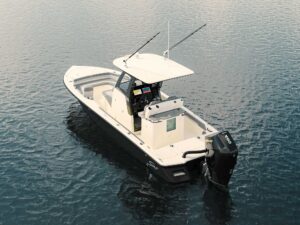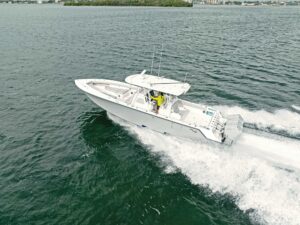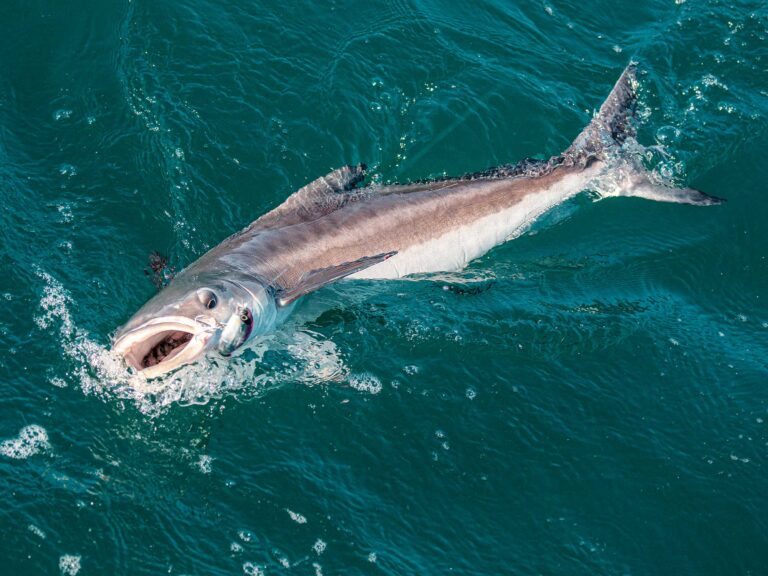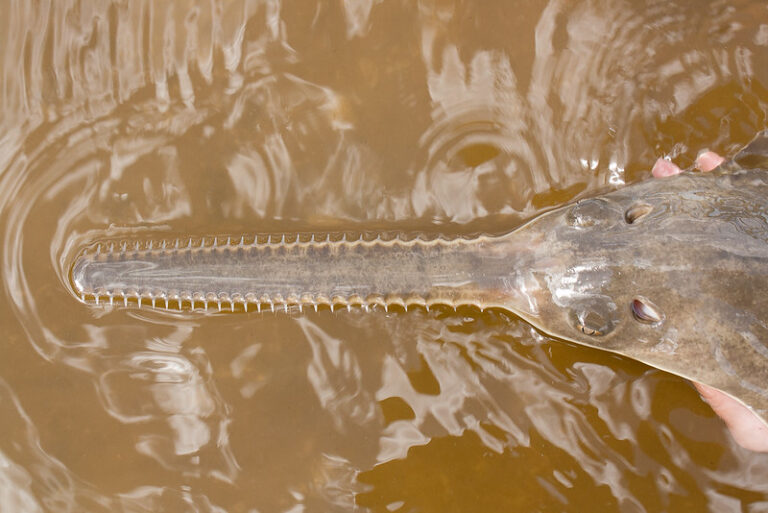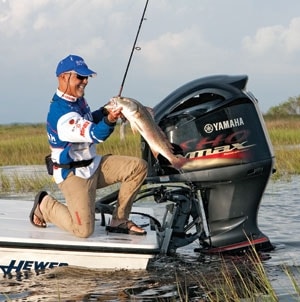
For all the ravings about the fuel efficiency and quiet running of four-stroke outboards, two-strokes have always had key performance aspects that four-strokes couldn’t match: superior power-to-weight ratios, plus more torque for a better hole shot and midrange acceleration. And modern two-strokes, such as the Evinrude E-Tec and Mercury’s OptiMax, equal most four-strokes in fuel economy and quietness, so what’s left for four-strokes? You don’t have to burn oil?
Well, Yamaha’s new VMAX SHO (super-high output) family of four-strokes is poised to turn the two-versus-four debate on its head. For flats and bay boats and small center consoles, the new VMAX SHO should provide the hole shot and giddyap normally reserved for two-strokes, and a whole lot more.
Four-Stroke Diet
The VMAX SHO line of 250, 225 and 200 hp outboards is based around a 4.2 liter V-6 powerhead. That’s more displacement than the old 3.3 liter V-6 model and slightly more than the heavier (578-pound) 4.0 liter V-6 Suzuki 250SS. The new block also has a larger throttle valve, bigger intake and exhaust valves, and larger lower unit water pickups than the old VMAX Series 2 two-stroke it replaces. Even so, at 505 pounds, the new engine is 34 pounds lighter than its predecessor and, as of now, claims the best power-to-weight ratio of any outboard – four-stroke or two- – in its class.
How did they shed all that weight? It started in the powerhead. “The plasma fusion technology allowed us to increase displacement without increasing weight,” says Martin Peters of the Yamaha Marine Group.
The plasma-fused sleeveless cylinder design is also found in BMW and Porsche race cars, as well as Rolls-Royce aircraft engines. Here’s how it works: Engineers inject a fine powdered-metallic coating material into a plasma stream (a heated gas like argon or nitrogen). It’s cooked at ultrahigh temps and sprayed on the metallic-alloy cylinder walls. The resulting plasma fusion finish is 60 percent harder than a conventional steel cylinder sleeve, with very low friction and high resistance to abrasion and sliding wear.
Yamaha also sheds weight with a lighter engine pan, cowling and mounting bracket. So the VMAX SHO solves the four-stroke weight problem. Now, how about that hole shot?
Quick and Fast
Four-stroke outboards traditionally have a flat power curve in comparison to an equivalent two-stroke. As a result, boats powered by four-strokes often lag behind in climbing onto plane and in low and midrange acceleration. Even a lag of a few tenths of a second can make a difference in skinny water, when you may have only a small pocket of deep water to wind up your boat.
Performance numbers from a Hewes Redfisher 21 paired with the 250 hp VMAX SHO paint a different picture. The power curve resembles a two-stroke pattern, as the boat climbed on plane in 3.08 seconds and hit 30 mph in 6.55. Turning 5,900 rpm, the Hewes hit 71 mph. “Displacement is a big part of achieving the kind of power curve we wanted,” says Peters. “The 4.2 liter also employs variable camshaft timing, which allows us to further tailor the power curve.”
Fuel economy does not look compromised, as the Hewes burned 4.8 gph to achieve a 5.7 mpg economy at 2,500 rpm. At a wide-open 5,900 rpm, it burned 23.6 gph for 3 mpg.
How will these new engines hold up? Only time will tell, but Yamaha has a well-earned reputation for reliability in saltwater circles, and its internal field testing indicates durability will not be an issue.
More on the Floor, Offshore
Yamaha is also putting this new 4.2 Liter V-6 powerhead to work in its Offshore series for its F300, F250 and F200 models. Everything’s leaner and meaner. The new V-6 F300 is 246 pounds lighter than the V-8 it replaces in the lineup. That’s like taking an NFL linebacker off the transom.
Yamaha is also bringing back its popular 3.3 liter F250 with old-school mechanical controls so boaters who want to repower but not refit have an option for their binnacle or side-mount mechanical control boxes.
And finally, Yamaha has upgraded its big V-8 F350 to make it compatible with its Command Link Plus electronic control system.
Props to Match
Yamaha engineered new propellers, called VMAX Ventless, to help those VMAX SHO engines achieve peak performance. The old Series II props were designed with a vent to let the prop slip so the engine could build speed through the power curve. “The VMAX SHO produces power at lower revolutions per minute,” says Yamaha’s Martin Peters, “so it’s not necessary to induce the slip.”
The new three-blade Ventless design allows the props to grip and helps the boat come fast out of the hole. The Ventless VMAX props are right-hand rotating only and available with 23-, 25-, 27- or 29-inch pitch.
For the rest of the engine line, the new Saltwater Series II props are labeled SDS for its new shift dampener system. The SDS is designed to reduce shifting noise by absorbing the force an outboard generates while shifting into forward or reverse. Anglers fishing in stealth mode will appreciate the smoother shifting and the elimination of the old clunking noise.
Yamaha also has new XL4 and XL4-HP props to go with its big V-8s. The XL4 is suited for heavier express cruisers and walkarounds, while the XL4-HP is geared toward tournament-style center console applications.

